Chapter 4: Calculating Fractal
Dimensions
" It is the glory of
geometry that from so few principles, fetched from without, it is able to
accomplish so much."
Sir Isaac Newton[1]
In classical geometry, shapes have integer
dimensions. A point has a dimension of ![]() , a line has a dimension of
, a line has a dimension of ![]() , an area has a dimension of
, an area has a dimension of ![]() and volume has a
dimension of
and volume has a
dimension of ![]() . From these elements--points, lines, areas and volume--we
derive the basic shapes of traditional geometry: triangles, squares, circles,
cones, cubes and spheres .
. From these elements--points, lines, areas and volume--we
derive the basic shapes of traditional geometry: triangles, squares, circles,
cones, cubes and spheres .

Figure 4.1 Traditional
dimensions point, line, square and cube.
We can use non-spatial
dimensions--time, color and perspective--to add dimension to otherwise
static objects. For example, you may have seen an image on a ![]() -dimensional computer screen
that appears
-dimensional computer screen
that appears ![]() -dimensional because of perspective. Using computer-generated
perspective, architects can visually walk through a entire building's design
before construction even begins see Figure 4.2 and Color Plate 22. Using color
changes, scientists can display thermodynamic heat fluctuations that can be
used to indicate venerable points with low heat dissipation. By plotting sound
frequencies over time, acoustical engineers use visual representations to show
how different harmonic patterns interact. See Figure 4.3 and Color Plate 23 to
see how changing colors can add information associated with dimension.
-dimensional because of perspective. Using computer-generated
perspective, architects can visually walk through a entire building's design
before construction even begins see Figure 4.2 and Color Plate 22. Using color
changes, scientists can display thermodynamic heat fluctuations that can be
used to indicate venerable points with low heat dissipation. By plotting sound
frequencies over time, acoustical engineers use visual representations to show
how different harmonic patterns interact. See Figure 4.3 and Color Plate 23 to
see how changing colors can add information associated with dimension.

Figure 4.2 Computer
rendering of a ![]() -dimensional view.
-dimensional view.

Figure 4.3 An added
dimension represented by color (shade) changes[2].
By using non-spatial dimensions, mathematicians and
scientists have explored spaces beyond traditional ![]() -dimensions. Examples include
-dimensions. Examples include ![]() -dimensional 'cubes' called tesseracts. These cubes when
viewed in
-dimensional 'cubes' called tesseracts. These cubes when
viewed in ![]() -dimensions appear as seven
cubes that share common sides with each other see figure 4.4. While no
tesseract can physically be built, understanding these structures can offer
insights into real world problems such as optimizing a network's path to follow
the shortest distance. Physicists and
mathematicians, routinely formulate even higher dimensions, known as ordered
states, to manipulate complicated equations that would be much harder to work
with at a lower dimension. It is not uncommon for atomic physicists to work
with a dimensional space in the teens in order to keep track of all possible
states of particles found at the subatomic level.
-dimensions appear as seven
cubes that share common sides with each other see figure 4.4. While no
tesseract can physically be built, understanding these structures can offer
insights into real world problems such as optimizing a network's path to follow
the shortest distance. Physicists and
mathematicians, routinely formulate even higher dimensions, known as ordered
states, to manipulate complicated equations that would be much harder to work
with at a lower dimension. It is not uncommon for atomic physicists to work
with a dimensional space in the teens in order to keep track of all possible
states of particles found at the subatomic level.

Figure 4.4 Tesseract, a ![]() -dimensional drawing of a
-dimensional drawing of a ![]() -dimensional object.
-dimensional object.
It is sometimes difficult to imagine these higher
dimensions. Here we have taken an excerpt from the book Flatland[3] a romance of many
dimensions, where Pointland, Lineland and Spaceland all see the same world
differently to aid in visualizing different dimensions.
 Excerpt from Flatland
Excerpt from Flatland

4.5 Map of lands with
different dimensions from the book Flatland.
" §
1.-Of the Nature of Flatland
I call our world Flatland, not because we call it
so, but to make its nature clearer to you, my happy readers, who are privileged
to live in Space.
Imagine a vast sheet of paper on which
straight Lines, Triangles, Squares, Pentagons, Hexagons, and other figures,
instead of remaining fixed in their places, move freely about, on or in the
surface, but without the power of rising above or sinking below it, very much
like shadows - only hard and with luminous edges - and you will then have a
pretty correct notion of my country and countrymen. Alas, a few years ago, I should have said "my universe": but now my mind has been opened to higher
views of things.
In such a country, you will perceive at once that it
is impossible that there should be anything of what you call a
"solid" kind; but I dare say you will suppose that we could at least
distinguish by sight the Triangles, Squares, and other figures, moving about as
I have described them. On the contrary,
we could see nothing of the kind, not at least so a to distinguish one figure
from another. Nothing was visible, nor
could be visible, to us, except Straight Lines; and the necessity of this I
will speedily demonstrate.
Place a penny on the middles of one of your tables
in Space; and leaning over it, look down upon it. It will appear a circle.
But now, drawing back to the edge of the table,
gradually lower your eye (thus bringing yourself more and more into the
condition of the inhabitants of Flatland), and you will find the penny becoming
more and more oval to your view; and at last when you have placed you eye
exactly on the edge of the table (so that you are, as it were, actually a Flatlander)
the penny will then have ceased to appear oval at all, and will have become, so
far as you can see, a straight line.
The same thing would happen if you were to treat in
the same way a Triangle, or Square, or any other figure cut out of pasteboard. As soon as you look at it with your eye on
the edge on the table, you will find that it ceases to appear to you a gure,
and that it becomes in appearance a straight line. Take for example an equilateral Triangle - who represents with us
a Tradesman of the respectable class.
Fig. 1 represents the Tradesman as you would see him while you were
bending over him from above; figs. 2
and 3 represent the Tradesman, as your would see him if your eye were close to
the level, or all but on the level of the table; and if your eye were quite on
the level of the table (and that is how we see him in Flatland) your would see
nothing but a straight line."
(1) (2) (3)
Edwin
A. Abbott
•••
Now lets briefly look at
mathematical tools developed over the centuries that help us to understand
fractals.
Infinite Lengths and Scale Ability a prelude to
fractals.
Many of the principles found
in fractal geometry[4] have origins in earlier
mathematics. For example scale ability and line lengths have long been
associated with geometrical structures. In Elements, Euclid ( 330- 275 B.C. )
proposed lines with infinite lengths to illustrate the concept of parallel
lines, there he also used self-similar triangles to show the congruency of
triangles see Figure 4.6. Archimedes (287-212 B.C.) used spirals to illustrate
repeating transformations. Later the mathematician Jacob Bernoulli (1654-1705)
expanded this idea to show that some spirals could be drawn with an infinite
length, of which the logarithmic spiral is the most famous see Figure 4.7.
Another well known spiral with infinite length is the golden mean spiral
derived from the ancient Greek's golden ratio ![]() see Figure 4.8. This
spiral closely resembles the sea creature, nautilus seen in Figure 3.89 in
Chapter 3.
see Figure 4.8. This
spiral closely resembles the sea creature, nautilus seen in Figure 3.89 in
Chapter 3.
Figure 4.6 Parallel lines of
infinite lengths and triangles within triangles.
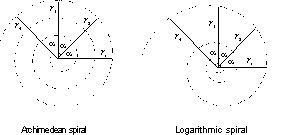
Figure 4.7 Spirals with
finite and infinite lengths.

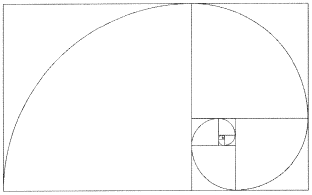
Figure 4.8 Golden ratio
spiral.
Similar spirals made using
FractaSketch can be seen in Appendix B.
Along with geometrical transformations seen in
scaling, mathematical equations too can be transformed. An example of this is
seen here with logarithms and with iterated function systems in Chapter 5.
Logarithms as
Mathematical Transformation
John Napier (1550-1617) originally invented
logarithms (represented as log) to simplify multiplication. By converting two
numbers to their corresponding log values, adding them together, and then
reversing the process, he showed how a close approximate product of two numbers
could be relatively easily calculated. Before computers, logarithms were an
invaluable method for multiplying large numbers, along with solving division
problems, calculating powers and roots. Here is a list of logarithm
transformations:
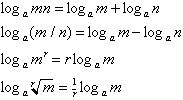
Figure 4.9 Table of Logarithm Transformations.
A logarithm's base can have any positive value. The most common values are ![]() and
and ![]() [5] denoted by
[5] denoted by ![]() .
.
Centuries later these logarithms would be crucial in
the calculation of fractal dimension as seen in the following sections.
The Hausdorff-Besicovitch Dimension
" As far as the laws of
mathematics refer to reality, they are not certain; and as far as they are
certain they do not refer to reality."
Albert
Einstein
Felix Hausdorff (1868-1942)
and Abram Besicovitch(1891-1970) revolutionized mathematics by proposing
dimensions with non-integer values. They demonstrated that though a line has a
dimension of ![]() and a square a
dimension of
and a square a
dimension of ![]() , many curves have an
"in-between" dimension related to the varying amounts of information
they contain. We refer to such in-between dimensions as the
Hausdorff-Besicovitch dimension.
, many curves have an
"in-between" dimension related to the varying amounts of information
they contain. We refer to such in-between dimensions as the
Hausdorff-Besicovitch dimension.
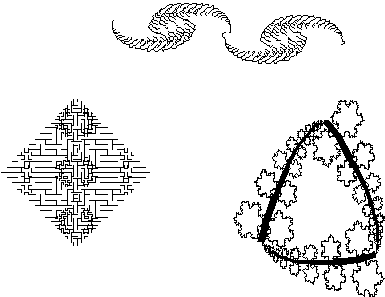
Figure 4.10 Dimensions
caught in the middle.
To explore the Hausdorff-Besicovitch dimension, we
will look first at traditional dimensions ( lines, area and volume) and then
explore expanded dimensions of fractals using three methods of
calculations:
•
1. The exactly self-similar method for calculating dimensions of mathematically
generated repeating patterns.
•
2. The Richardson method for
calculating a dimensional slope.
•
3. The box-counting method for determining the ratios of a fractal's area or
volume.
Calculating
Traditional Dimensions
" One must say- instead of points, straight lines and planes
- tables chairs and beer mugs"
David
Hilbert
To calculate a fractal's dimension, we simply extend
the formula for calculating traditional dimensions, so let's begin with this
basic formula. Look at the dimensional relationship of how a line, a square and
a cube are linked together dimensionally in Figure 4.11.
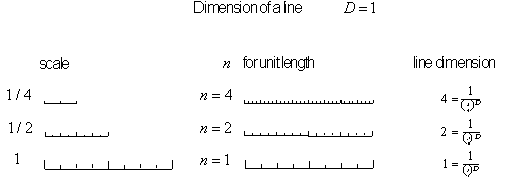
Figure 4.11.
Illustration of line segments, ![]() and scaling factors,
and scaling factors, ![]() raised to the
appropriate dimension
raised to the
appropriate dimension ![]() .
.
The number of line segments ![]() of a unit, is equal
to the inverse of the scaling factor
of a unit, is equal
to the inverse of the scaling factor ![]() , raised to the appropriate dimension
, raised to the appropriate dimension ![]() .
.
•
The general equation is represented by: ![]()
The first three integer dimensions are ![]() =
=![]() for a line,
for a line, ![]() =
=![]() for a square, and
for a square, and ![]() =
=![]() for a cube
for a cube
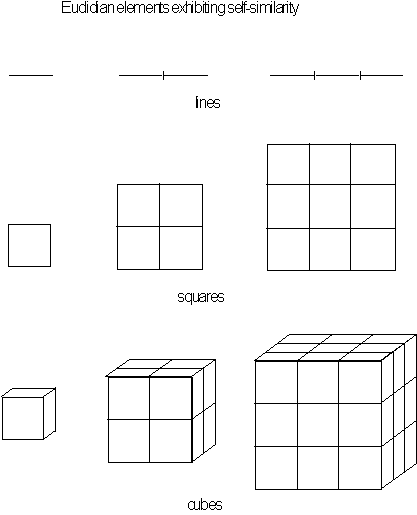
Figure 4.12 Basic
construction of lines, squares and cubes of unit lengths ![]() ,
,![]() ,
,![]() .
.
The list below shows the number of pieces ![]() in relationship to
in relationship to ![]() vs.
vs. ![]() , for a given line, square
and cube.
, for a given line, square
and cube.
values:
line square cube
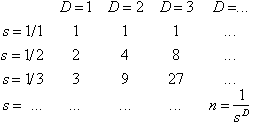
Figure 4.13. Table of the number of segments n in
relationship to ![]() vs.
vs. ![]() .
.
Though non-spatial dimensions expanded the range of
dimensions we can explore, these dimensions are still whole, or integer,
dimensions. Not until recently, with
the advent of fractal geometry, have we begun to explore partial, or fractional,
dimensions. In this section, we will look at these fractal dimensions.
Calculating Dimensions of Self-Similar Fractals
Calculating the fractal dimension of exactly
self-similar shapes is fairly straightforward. This approach, which is limited
to fractals whose structure can be predetermined mathematically, produces
precise values. These are the linear fractals we saw in Chapter 3.
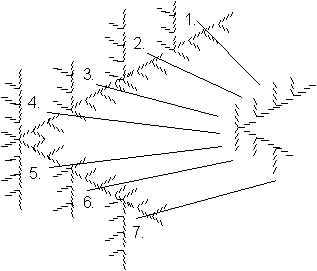
Figure 4.14 Exactly
self-similar fractal.
Recall that the basic equation for calculating
dimension is: ![]()
Although there is no rule that dimension ![]() has to have an integer value, this has been the convention in
traditional geometry. Here we will carry out numeric calculations, for many different values of
has to have an integer value, this has been the convention in
traditional geometry. Here we will carry out numeric calculations, for many different values of ![]() and
and ![]() , where
, where ![]() is not an integer dimension, but rather a 'fractional' or
'partial' dimension.
is not an integer dimension, but rather a 'fractional' or
'partial' dimension.
Given:
![]() the
familiar case.
the
familiar case.
![]() take
take ![]() of both sides.
of both sides.
![]() factor the exponent
factor the exponent ![]() out of the scale
factor.
out of the scale
factor.
![]() divided by
divided by
![]() to set the equation equal
to
to set the equation equal
to ![]() .
.
We are left with the equation:
![]()
In a true mathematical
fractal, replacing the line segments with seeds is a never ending process.
Therefore the general case
is written ![]() , where
, where ![]() represents the level the fractal "seed" has been
replicated.
represents the level the fractal "seed" has been
replicated.
Which gives ![]() where
where ![]() = the level of replication.
= the level of replication.
However since ![]() is found in both the nominator and the denominator of the equation
it can be neatly factored out, so we are still left with the basic equation:
is found in both the nominator and the denominator of the equation
it can be neatly factored out, so we are still left with the basic equation: ![]() where the exponent
where the exponent ![]() is factored out .
is factored out .
The formal fractal dimension
equation for ![]() is given as the
is given as the ![]()
![]() .
.
Calculating
the Dimension of the Koch Curve
Now
lets apply the formula that we have derived in the previous section to the Koch
curve. This curve makes a good example because its construction is uniform and
we can calculate its dimension with relative ease.
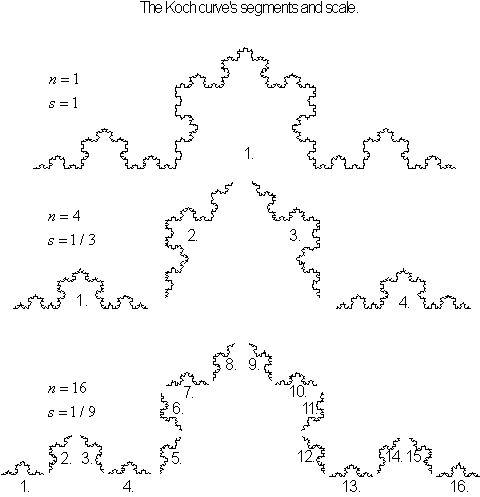
Figure 4.15 Koch curve
showing ![]() levels for
levels for ![]() and
and ![]() values.
values.
From Chapter 3, we know the number of line segments
in the Koch curve is ![]() and that each line
segment is replaced by a replica of the original, reduced in scale by
and that each line
segment is replaced by a replica of the original, reduced in scale by ![]() . To calculate the
dimension:
. To calculate the
dimension:
•
Use the basic dimension equation ![]() .
.
•
Replace ![]() with
with ![]() , for the number of unit line segments and
, for the number of unit line segments and ![]() with
with ![]() , for the scale factor. The equation now becomes
, for the scale factor. The equation now becomes ![]() , or simply
, or simply ![]() .
.
•
To find ![]() , take the log of both sides. Simplify and you are left with
, take the log of both sides. Simplify and you are left with ![]() .
.
Now lets use what we just learned to calculate the
dimension for the Koch Snowflake.
The Dimension
calculated for the Koch Snowflake
The Koch Snowflake can be created using two
distinctive techniques. One method used assembles the Koch Snowflake from
perimeter components of the Koch curve, the other method produces the entire
the Koch Snowflake from a single generated curve.
Perimeter
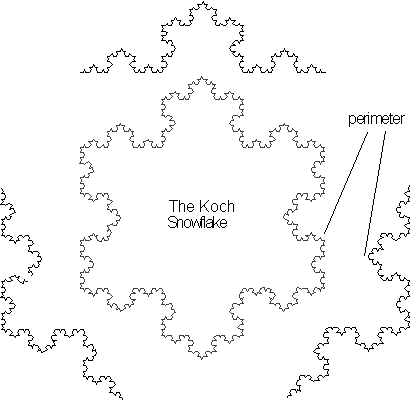
Figure 4.16 The Koch
snowflake constructed by connecting edges of the Koch curve shown with ![]() .
.
The first technique uses three Koch curves which are
joined together at the edges as seen in Figure 4.16 to form the Koch snowflake.
Since the construction of these curves involves calculations only involving the
outer boundary, the fractal dimension calculated will be that of its perimeter,
the Koch curve.
Inner
dimension
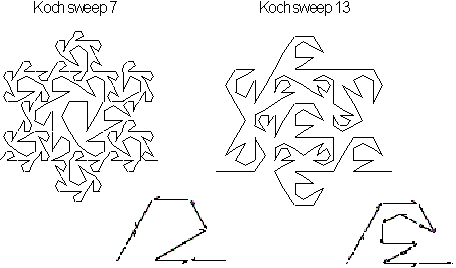
Figure 4.17 Two
different seeds producing the Koch snowflake.
The second technique involves the construction of
the whole Koch snowflake from a single seed. Many varying seeds can be used as
seen in Figure 4.17. Since the entire snowflake is formed from a single seed
the calculated dimension will be that of the entire curve.
Now lets look at the dimension of one variety call
the 7 Snowflake Sweep. As seen from the curve not all replacement components
have the same length, so the basic equation for calculating the exact dimension
can not be used here. So then how do we
calculate its dimension? We
begin by looking at how the overall snowflake curve is formed. The basic seed
has 7 line segments with 6 reduced by ![]() scale and 1 reduced
by
scale and 1 reduced
by ![]() scale. If all the
line segments were reduced by the scale
scale. If all the
line segments were reduced by the scale ![]() the dimension
equation would be simply
the dimension
equation would be simply ![]() . However, since at least one segment is reduced by a scale
. However, since at least one segment is reduced by a scale ![]() of a lesser amount, namely
of a lesser amount, namely ![]() , the dimension of the curve has to be greater and a ratio
relationship has to be establish between the different scaling values.
, the dimension of the curve has to be greater and a ratio
relationship has to be establish between the different scaling values.
The equation we use
to develop this ratio relationship is given by ![]() .
.
For the Snowflake Sweep's exact calculation is given
by ![]() . Calculating the dimension form this equation
we find
. Calculating the dimension form this equation
we find ![]() .
.
This value corresponds to the observed value,
dimension ![]() , of the Snowflake Sweep curve that covers the area of a
plane. This region is referred to as its inner dimension.
, of the Snowflake Sweep curve that covers the area of a
plane. This region is referred to as its inner dimension.
As we have just seen the Koch Snowflake actually has
two types of dimensions: one for its perimeter and one for its inner region. In
the following section we will see how to numerically calculate other exactly
self-similar fractals with varying
scaling values.
Other curves
with a perimeter and inner dimension.
All fractal curves with area ( inner dimension ![]() ) also have a perimeter dimension. Here we will look at two
more examples: the Gosper island and later the Dragon curve. Some fractals with
an inner dimension of less than
) also have a perimeter dimension. Here we will look at two
more examples: the Gosper island and later the Dragon curve. Some fractals with
an inner dimension of less than ![]() also have an alternate perimeter dimension, as we will see with
the Monkey Tree fractal. As shown with the Koch Snowflake, dimensions
calculated relate to the specific seed used to construct it. For example if a
perimeter curve is used to create a fractal, that curve's dimension relates to
its boundary, accordingly if a curve's construction is that of a complete
fractal the dimension calculated will be that of its entire structure.
also have an alternate perimeter dimension, as we will see with
the Monkey Tree fractal. As shown with the Koch Snowflake, dimensions
calculated relate to the specific seed used to construct it. For example if a
perimeter curve is used to create a fractal, that curve's dimension relates to
its boundary, accordingly if a curve's construction is that of a complete
fractal the dimension calculated will be that of its entire structure.
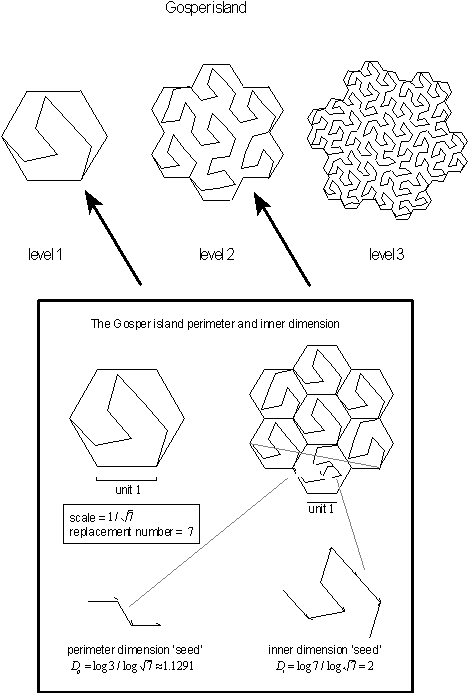
Figure 4.18 Gosper
island with both perimeter and inner dimension.
As with the Koch snowflake, the Gosper island[6] too can be created by
placing perimeters together or from a single seed. The calculated perimeter
dimension is given by ![]() segment lengths each
reduced by a scale s of
segment lengths each
reduced by a scale s of ![]() . This results in a perimeter dimension that is calculated to
be
. This results in a perimeter dimension that is calculated to
be ![]() . Since entire Gosper curve fills an area it has an inner
regional dimension of
. Since entire Gosper curve fills an area it has an inner
regional dimension of ![]() . This can be seen in Figure 4.21 that shows a numerically
calculated value of
. This can be seen in Figure 4.21 that shows a numerically
calculated value of ![]() .
.
Figure 4.19 Calculating the Gosper island in the
plane dimension.
Now lets look at calculating an exact fractal with
different segment lengths whose inner dimension is less than ![]() .
.
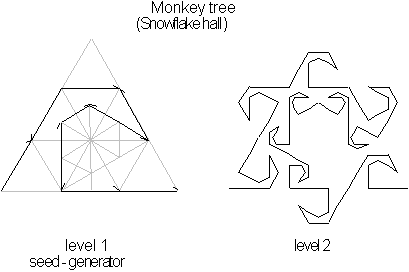
Figure 4.20 The Monkey
Tree's seed generator and its next growth level.
The Monkey Tree[7] seed uses two different
segment lengths for ![]() , each with a different scaling value for
, each with a different scaling value for ![]() to generate its
fractal, six with =0.333 and five with =0.186. Its over all dimension is given
by the segment's ratio where
to generate its
fractal, six with =0.333 and five with =0.186. Its over all dimension is given
by the segment's ratio where ![]() or
or ![]() .
.
 Monkey Tree Maze Game.
Monkey Tree Maze Game.
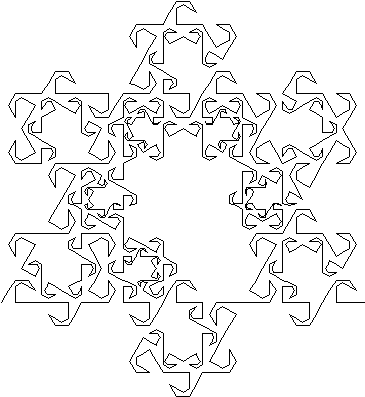
Figure 4.21 Monkey
Tree Maze.
The Monkey Tree curve makes for a visually appealing
maze with its many turns and empty regions. Since the Monkey Tree is created
from one continuous curve that never overlaps, a path can be made from any
region that escapes to the outside. To see this more clearly randomly choose a
section within the curve in Figure 4.21 and see how fast you can find a way
out. If you get stuck you can follow the curve path for the exit.
Calculating
the Dimensions of the Varying Dragon Curves
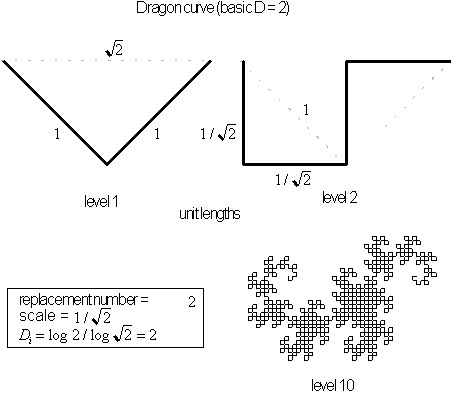
Figure 4.22 Component
lengths and completed form of the Dragon curve.
We begin our calculation of the dragon curve's
dimension with its most basic construction, in which two seed segments of length ![]() replaces a single
line segment with length
replaces a single
line segment with length ![]() . This results in a
scale reduction,
. This results in a
scale reduction, ![]() , of
, of ![]() . The dimension is calculated to be
. The dimension is calculated to be ![]() . This curve is contained and fills a region with a confined
area as seen in figure 4.22.
. This curve is contained and fills a region with a confined
area as seen in figure 4.22.
The dragon curve comes in variety of forms with
differing dimensions. In the following section we will see some of these
variations.
Now lets look at what happens if we lower the
fractal dimension of the seed for the basic dragon curve.
Lower
dimensions, its area disappears.
If line segments were shortened the fractals
dimension would be reduced and it would no longer cover an area. This can be
done by shortening seed segments at the same time keeping the starting and
ending points constant or by increasing the distance between the beginning and
end points. For illustrations on dragon curves with dimensions less than
dimension-![]() see figure 4.23.
see figure 4.23.
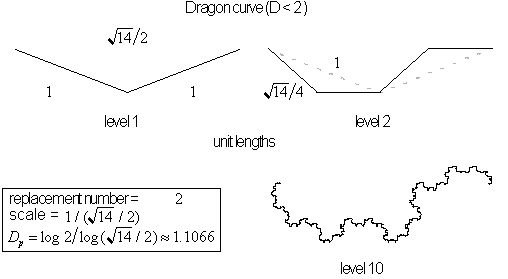
Figure 4.23 Dragon
curves with dimension less than ![]() .
.
Now lets look what happens to a dragon curve whose
component lengths (generator) are increased in relationship to its overall
length (initiator).
Higher
Dimension Seeing How Some Fractals Can Grow Forever.
If we decrease the Dragon Curve seed's segment angle
its calculated dimension would also increase. This can be done by lengthening
seed segments at the same time keeping the starting and ending points constant
or by reducing the distance between the beginning and end points of the seed.
Unlike other fractals we have seen earlier, which are limited to an confined
space, fractals with 'calculated'
dimension greater than ![]() can continue to
expand outwardly from the center forever. If a seed segment line is longer than
the distance between the starting point and the ending point of the seed the
fractal will diffidently continue to do so, see Figure 4.24.
can continue to
expand outwardly from the center forever. If a seed segment line is longer than
the distance between the starting point and the ending point of the seed the
fractal will diffidently continue to do so, see Figure 4.24.
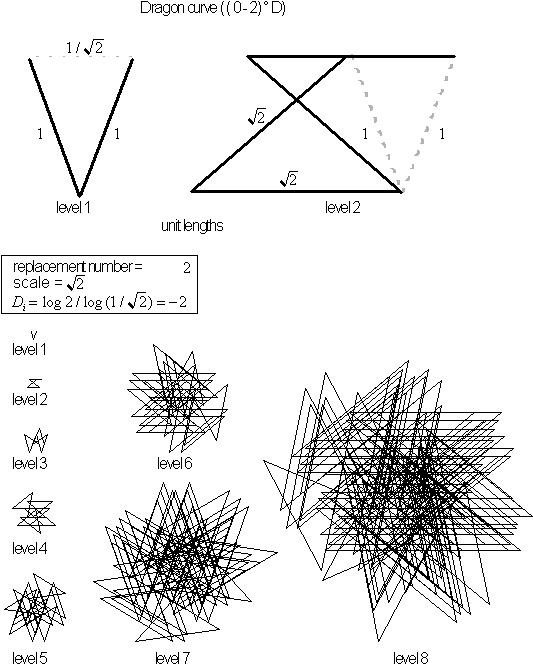
Figure 4.24 Dragon
curve with scaling value greater than ![]() .
.
Now what would happen when we use two line
replacements whose lengths are greater than![]() . The new 'calculated' dimensions will fall in 3 parts:
. The new 'calculated' dimensions will fall in 3 parts:
I. scale
![]() , where the dragon structure grows continuously in relation
to its scaling factor and its calculated dimension range is
, where the dragon structure grows continuously in relation
to its scaling factor and its calculated dimension range is ![]() .
.
II. scale
![]() , a special case where all 'seed' replacements over lap
causing a growing triangular grid with uniform density, see Figure 4.25.
, a special case where all 'seed' replacements over lap
causing a growing triangular grid with uniform density, see Figure 4.25.
III. scale
![]() where 'calculated' dimensions have negative values and the
fractal will always continue to expand for higher levels of the curve.
where 'calculated' dimensions have negative values and the
fractal will always continue to expand for higher levels of the curve.
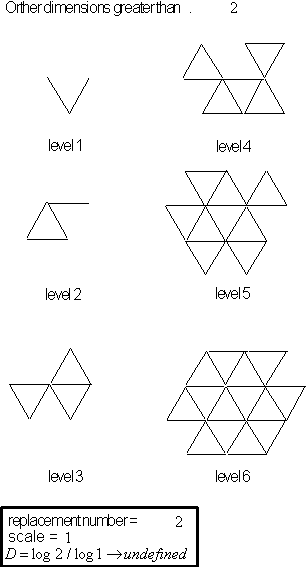
Figure 4.25 Dragon
curve with a scaling length equal to segment length.
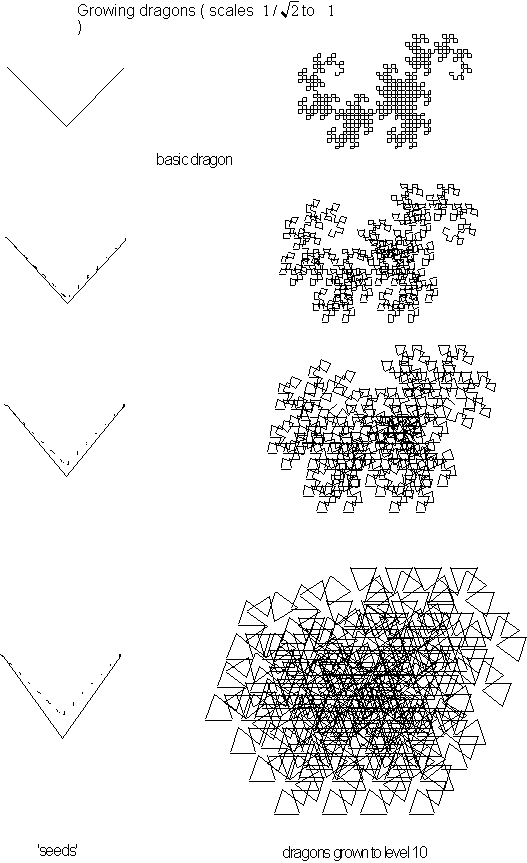
Figure 4.26 Four, 2
segment replacements with continually longer segment lengths and their growth.
Does this mean that our new fractal is greater than ![]() -dimensional? In the physical and mathematical world, the
answer is no because it is constrained to a
-dimensional? In the physical and mathematical world, the
answer is no because it is constrained to a ![]() -dimensional plane. In theory, however, the answer 'could be'
yes, a somewhat philosophical answer.
The dragon curve contains more mathematical information than is needed
to fill a plane. If we could find a way to liberate this fractal from its
confined space, its high dimensional curves could fill up a volume space
(similar to the way the twisted Hilbert curve segments do in Chapter 3). In
fact, some could even conceivably fill up a
-dimensional plane. In theory, however, the answer 'could be'
yes, a somewhat philosophical answer.
The dragon curve contains more mathematical information than is needed
to fill a plane. If we could find a way to liberate this fractal from its
confined space, its high dimensional curves could fill up a volume space
(similar to the way the twisted Hilbert curve segments do in Chapter 3). In
fact, some could even conceivably fill up a ![]() -dimensional space or greater if we could find one for it to
exist in. These principles hold true for other linear fractals too as we will
shall see using FractaSketch.
-dimensional space or greater if we could find one for it to
exist in. These principles hold true for other linear fractals too as we will
shall see using FractaSketch.
Let use FractaSketch to build an ever expanding
fractal.
 Using FractaSketch to Build an ever-growing
fractal.
Using FractaSketch to Build an ever-growing
fractal.
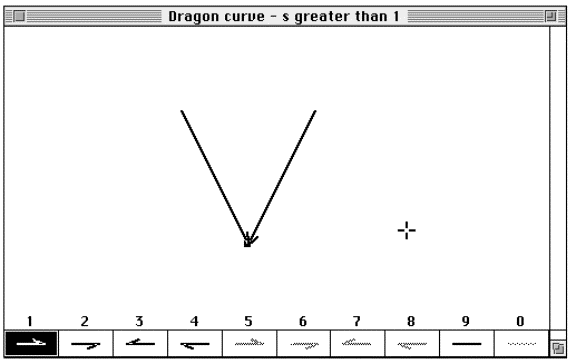
Figure 4.27 Dragon
with line segments greater than the its seed length.
Here we will use FractaSketch to grow fractals whose
mathematical dimensions are calculated to be greater than ![]() . A dragon seed works nicely, but any other fractal seed
following the same instructions should also work.
. A dragon seed works nicely, but any other fractal seed
following the same instructions should also work.
Step 1: Open a drawing pallet and
create a small fractal with at least one line segment that is longer than the
distance between the beginning and end points, as in Figure 4.27.
Step 2: Click on levels 2-10 to
watch the fractal grow. Notice that the
fractal continues to take up more and more area on the computer screen until
the screen in completely covered see Figure 4.28. The rate of growth depends on
the length of the seed's segment used. If the growth rate is very rapid you can
use the "Reduce" feature from the "Scale" menu as often as
needed to get a more complete view.
Step 3: Repeat the growth process
with seed lines of various lengths.
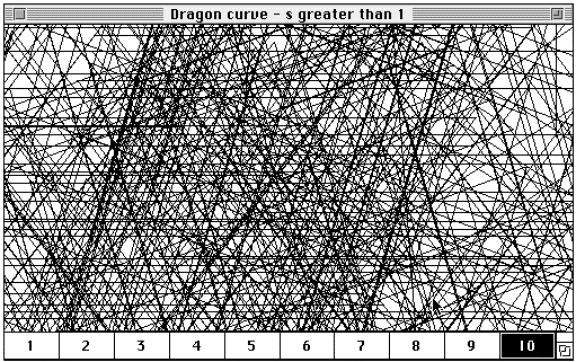
Figure 4.28 A growing
fractal 'seed' in FractaSketch that will increase in size at each higher level.
FractaSketch gives fractals that continue to grow
uncontrollable an uncertain calculated value of "??" in its menu bar,
see Figure 4.29.
![]()
Figure 4.29 Menu bar with uncertain dimension.
Now lets use what we have learned in pervious
sections to calculate the dimensions and apply these principles to objects that
reside in a volumetric space. Here we will look at two such examples: the
Menger sponge and the Sierpinski tetrahedron
or pyramid.
Calculating
Dimensions for the Menger sponge and Sierpinski Pyramid or tetrahedron
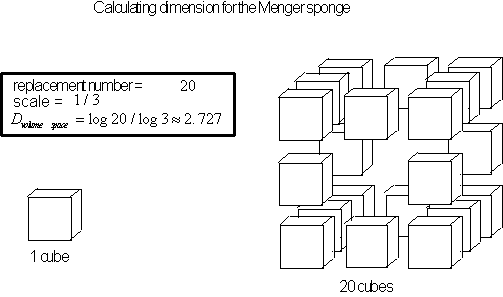
Figure 4.30 Components
of the Menger sponge.
The Menger sponge consists of a primary cube divided
equally into 27 smaller cubes, each a 1/3 scale copy of the original. Then the center cubes are removed from all 6
sides and the middle, leaving 20 smaller cubes. By using the exact method
formula we get a calculated dimension
for the Menger sponge of ![]() . An object residing in a 3-dimensional space whose
components take up no volume.
. An object residing in a 3-dimensional space whose
components take up no volume.
Note, if you take a line connecting any corner
diagonal points of the Menger sponge, their intersection would be that of the
Cantor set for that length.
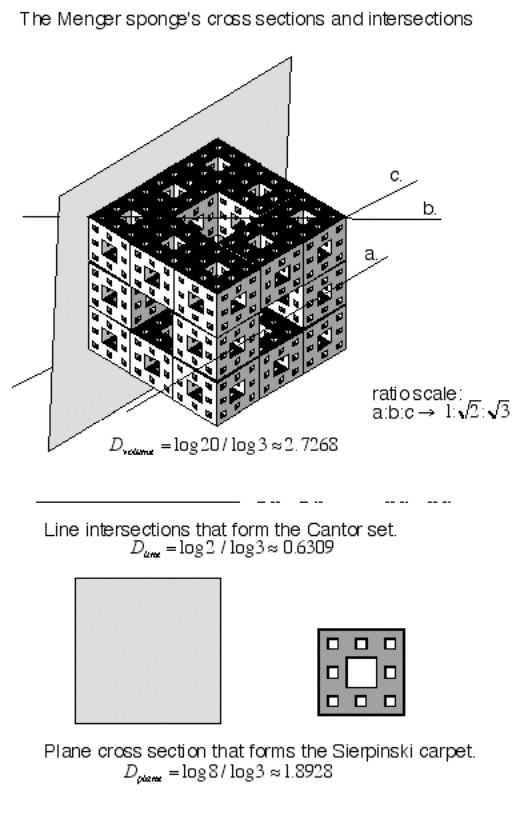
Figure 4.31 The Cantor
set found in the Menger sponge.
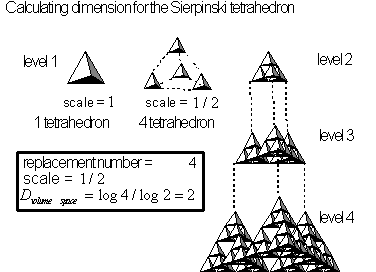
Figure 4.32
Calculating a Sierpinski pyramid (tetrahedron) dimension.
The Sierpinski pyramid consists of a primary pyramid
that is replaced by ![]() smaller pyramid each
smaller pyramid each ![]() the original scale.
The calculated dimension is equal to
the original scale.
The calculated dimension is equal to ![]() . The Sierpinski pyramid gives an example of a
. The Sierpinski pyramid gives an example of a ![]() dimensional object without
area. If such a pyramid existed, it would reside in a volumetric space with its
physical structure not taking up any volume space, even though its residing
space would be defined.
dimensional object without
area. If such a pyramid existed, it would reside in a volumetric space with its
physical structure not taking up any volume space, even though its residing
space would be defined.
 How are these
Fractals Alike ?
How are these
Fractals Alike ?
Can you guess what the fractals is Figure 4.33 have
in common ?
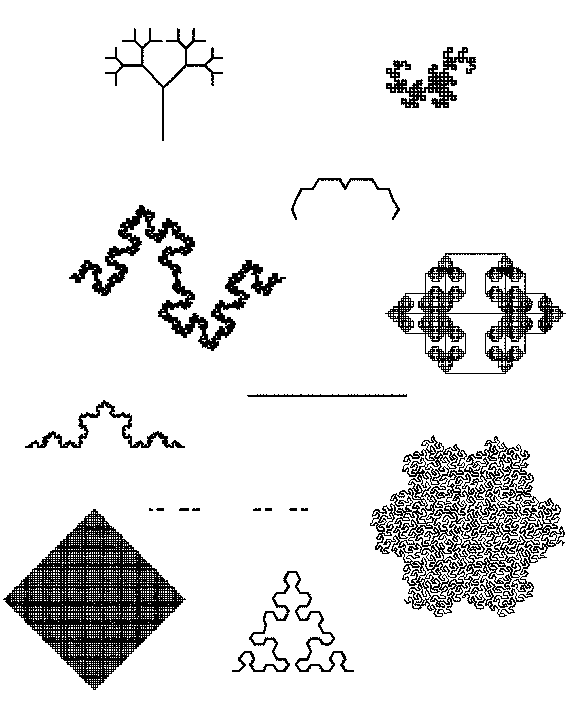
Figure 4.33 Assortment
of fractal images.
Answer: They all have a fractal dimension of roughly
1.5. If you look carefully you can see
that though each fractal has a different form, they all cover a similar amount
of the ![]() -dimensional plane.
-dimensional plane.
Next we will play the Totem Pole game in which we
will place fractals in order of their dimension.
 The Fractal Totem Pole Game
The Fractal Totem Pole Game
There are a number of objects in Figure 4.35 below, and each has been generated using a
number of equal line segments. Then the segments have been replaced with a
small replica of the whole object. This was repeated 4 times (level 4). The
goal of the game is to put the objects in order of their fractal dimension, and
to find their underlining seed-shape.
Hints: 1) divide the object into halves or thirds,
2) look at the ends for a recognizable seed-shape of the whole, 3) check the
density of area being covered. Generally, the more solid the area is, the
higher the fractal dimension. Also notice disproportionately long lines, as
they generally indicate lines that have not been transformed.
Figure 4.34 Images to put in order of their fractal
dimension.
Now use FractaSketch to see if you can create totem
pole fractals, if you haven't done so already.
Answers to the Totem Pole Game showing a list of
their exactly calculated fractals can be seen on the next page.
Figure 4.35 The Totem Poles seeds and their
corresponding dimensions.
For examples of other fractals with exactly
calculated dimensions see Gallery of Fractals in Appendix B.
In the next
section we will use another method to calculate fractal dimension. This
technique called the Richardson method is generally used when an object has a
fractal structure that is not exactly repeating, such as a coastline, and
therefore the exact method can not be applied.
The Richardson's Method of varied measured lengths.
" Big whorls have little whorls,
Which feed
on their velocity;
And little
whorls have lesser whorls
And so on
to viscosity
(in a molecular sense). "
-
Lewis Fry Richardson[8]
Lewis Fry Richardson (1881-1953), an English meteorologist, pioneered a
process for calculating dimensions with varied measurements. Using this
technique an object's perimeter is measured with rulers of different lengths,
then by graphing its slope the corresponding dimension is calculated. His work
compared the dimensional slopes of coasts, such as Great Britain, that remain
jagged at many levels of magnification, to non-fractal boundaries like circles
that remain smooth[9].
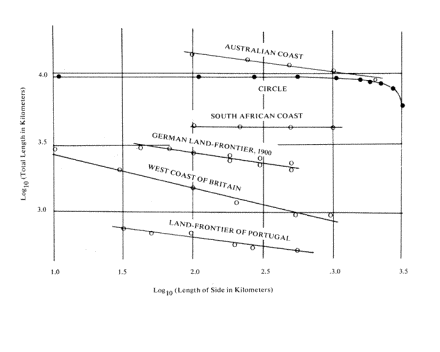
Figure 4.36 Dimensions
of coastlines vs. a circle, Richardson's calculations. Illustration from The
Fractal Geometry of Nature, © 1982 Benoit Mandelbrot.
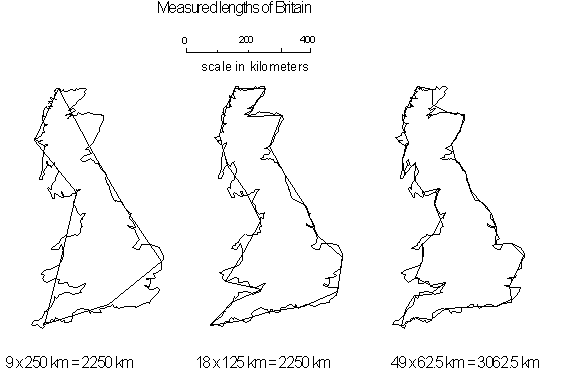
Figure 4.37 Measured
segments for the coast of Britain[10].
Though Richardson[11] had spent many years in
researching boundaries, it was not until 1961, eight years after his death,
that the results of his experiments were published. In his paper,
Richardson points out that countries
with common borders often report different border lengths as he notice from
examining various encyclopedias. For example, Spain claimed its boarder with
Portugal was 987 km, whereas Portugal claimed it was 1214 km . Similarly,
Holland claimed its border with Belgium was 380 km, whereas Belgium claimed it
was 449 km.
Through graphs, Richardson tries to explain what
accounts for these relatively large differences in measurements, often varying
as much as 20%.[12] He suggests that the
different 'measuring sticks'[13] used by one country might be
disproportionally shorter, maybe even by an
factor of ![]() , than what an other country uses. Also, a small country might take more care in measuring its
boarder than a large country that has a greater perimeter to cover.
, than what an other country uses. Also, a small country might take more care in measuring its
boarder than a large country that has a greater perimeter to cover.
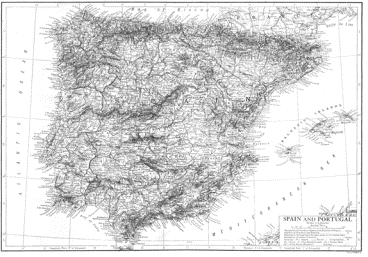
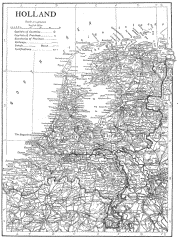
Figure 4.38 Borders of Spain and Portugal and
borders of Holland and Belgium.
This method that Richardson developed, also known as
varying slope dimension or compass dimension, is an effective technique for
measuring an object's perimeter fractal dimension. Although not as precise as
the method used for exactly self-similar objects, this procedure enables us to
calculate the dimensions of real-world objects, which are not perfectly
self-similar.
To calculate the dimension of perimeters with the Richardson
Method, you use 'rulers' of differing lengths. Then by comparing the measured
lengths of an objects perimeter to corresponding variations in ruler lengths
and plotting the results, a graph can be made with logarithmic scales, from
whose slope an object's dimension can be readily calculated. Logarithmic scales
are used because the exponent values associated with dimension, translate
easily to linear values that define a
slope. It is the object's structural changes, weather it becomes more detailed or
smoother, at various scales that is the object's fractal dimension.
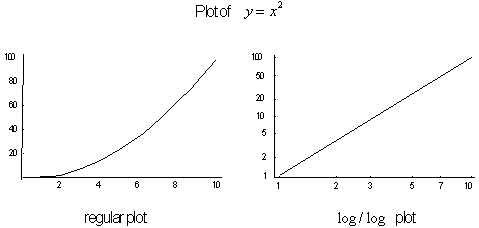
Figure 4.39 Measure
lengths on regular graph vs. logarithmic graph.
As you reduce the length of your measuring
"sticks", the precision of
your measurement increases, generally resulting in a greater apparent length
for objects with fractal dimension. For different objects, you should use an
appropriate measuring stick. For example, in measuring the coastline of Britain
you might measure it in units of 1000 km, 500 km, 100 km, 50 km, 20 km. (It is
easier, of course, to use maps with a corresponding scale.) For the circular
parameter of a wheel, your measurement might be in meters 1m, .5m, .1m, .05m, .02m. You might use a measuring tape
as a final measurement, which works well for wheel because there are not large
deviations on the surface.
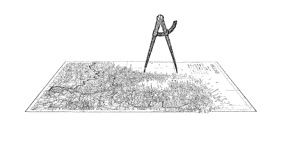
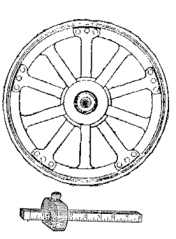
Figure 4.40 Measuring
perimeters using different measuring sticks.
Richardson's
Dimension Equation.
Let's look closer into the Richardson's method for
calculating fractal dimensions using varying measurement lengths. To calculate
a dimension, we first have to establish a logarithmic relationship between the
object's over all 'measured' length and the length of the 'ruler' used to
measure it. We do this by graphing various values of ![]() , where
, where ![]() is the length of the
perimeter, against the corresponding values of
is the length of the
perimeter, against the corresponding values of ![]() , where
, where ![]() is the scaling factor
(the rulers length), used in measuring the perimeter. The resulting slope of
the (
is the scaling factor
(the rulers length), used in measuring the perimeter. The resulting slope of
the (![]() /
/![]() ) graph will be the related fractal dimension of the measured
object.
) graph will be the related fractal dimension of the measured
object.
For a smooth or linear object, smaller rulers will
measure similar lengths as do larger ones, so the slope will be
horizontal. A graph with a horizontal
slope corresponds to the dimension ![]() . As the fractal dimension of an object increases, so does the
severity of the slope.
. As the fractal dimension of an object increases, so does the
severity of the slope.
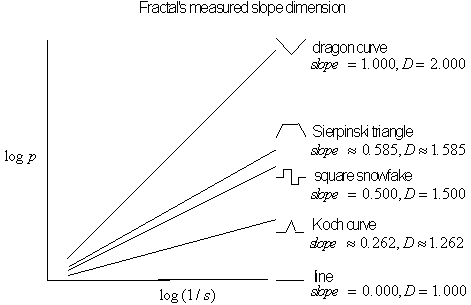
Figure 4.41 Different
slopes of ![]() /
/![]() corresponding to different fractal dimensions.
corresponding to different fractal dimensions.
The formula for the Richardson slope method is given
by the relationship ![]() , where
, where ![]() is the calculated
slope dimension of the
is the calculated
slope dimension of the ![]() graph added to the
dimensionally of a line with value
graph added to the
dimensionally of a line with value ![]() , and where
, and where ![]() is the calculated
standard dimension.
is the calculated
standard dimension.
Constructing
the Equation in a Familiar Form
Now lets formulate the Richardson equation we have
just seen. Later on we will compare the results with values calculated from the
exact method using the Koch curve.
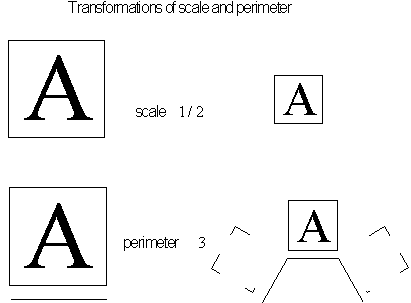
Figure 4.42 Scaling
values and perimeter values
• Select ![]() , the scale value equal to the ratio between the segment's
replacement length and the length of the corresponding seed shape. To plot
different points of the slope, various scales values will be used. Here the
scale measurement values are calculated for higher levels of replacement (a
decrease in ruler length) with the formula
, the scale value equal to the ratio between the segment's
replacement length and the length of the corresponding seed shape. To plot
different points of the slope, various scales values will be used. Here the
scale measurement values are calculated for higher levels of replacement (a
decrease in ruler length) with the formula ![]() . By using unit levels
. By using unit levels ![]() , scaling values can be easily calculated that correspond to
dimension
, scaling values can be easily calculated that correspond to
dimension ![]() .
.
• Calculate the perimeter length. The length
is given by ![]() .
.
• Set the two equations equal in terms of the
exponent value ![]() , so
, so ![]() .
.
• Simplifying we are left with ![]() and
and ![]() .
.
•
Now by setting both equations equal to ![]() and then solving, we
are left with a equation
and then solving, we
are left with a equation ![]() , with the constant
equal to
, with the constant
equal to ![]() which we set to
which we set to ![]() .
.
•
Rewriting the equation we get ![]() or simply the
perimeter equation
or simply the
perimeter equation ![]() , where
, where ![]() is the slope
dimension giving in the form
is the slope
dimension giving in the form ![]() .
.
Now lets see how to form the relationship ![]() . Remember
. Remember ![]() and
and ![]() are interchangeable
values.
are interchangeable
values.
•
First lets use the perimeter equation ![]() . Taking the logarithm of both sides we are left with
. Taking the logarithm of both sides we are left with ![]() .
.
•
Next take the equation for the number of line segments ![]() and proceed to put it
in the logarithmic form
and proceed to put it
in the logarithmic form ![]() .
.
•
Take the perimeter length given by ![]() , where perimeter length is equal to the number of pieces
multiplied by the scale. Now putting it in its logarithmic form, we derive
, where perimeter length is equal to the number of pieces
multiplied by the scale. Now putting it in its logarithmic form, we derive ![]() .
.
•
Now by substituting ![]() for
for ![]() and
and ![]() for
for ![]() we are left with
we are left with ![]() , which simplifies to
, which simplifies to ![]() .
.
Now lets construct the Koch curve using the Richardson method and compare the
results with its exact value calculated in the previous section.
Illustrating
the Richardson method using the Koch curve.

Figure 4.43 Components of calculating the Koch
curve.
• Set the scale value of the Koch curve to be ![]() ,
, ![]() .
.
• The perimeter length of the Koch curve is
given by ![]() ,
, ![]() .
.
• Setting the two equations in terms of t ![]() results in
results in ![]() .
.
• Simplifying, results in ![]() and
and ![]() .
.
•
Setting both equations equal to ![]() and solving we are
left with:
and solving we are
left with:
![]()
or
![]()
![]()
![]() .
.
Then by using an appropriate logarithmic value for
calculating the constant value, in the Koch curve's case ![]() , the results simplify to form a nicely factored equation[14]. This leaves the slope for
the Koch curve to be
, the results simplify to form a nicely factored equation[14]. This leaves the slope for
the Koch curve to be ![]() as seen in Figure
4.44.
as seen in Figure
4.44.
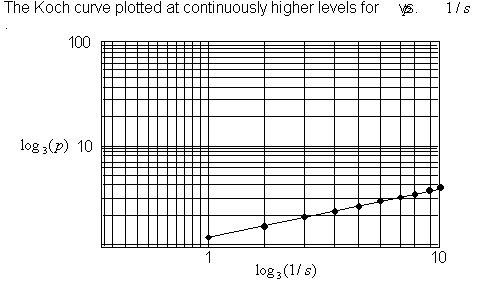
Figure 4.44 The Koch
curve's slope plotted on a ![]() /
/![]() graph.
graph.
So the calculated value with the Richardson method
for the Koch curve is ![]()
![]() . This value is in close agreement with the exact method's
calculation from the previous section.
Curiously, this calculated value is similar to the fractal dimension of
Britain's west coast. In the next section we are going to look at the fractal
dimensions of different states in the United States of America.
. This value is in close agreement with the exact method's
calculation from the previous section.
Curiously, this calculated value is similar to the fractal dimension of
Britain's west coast. In the next section we are going to look at the fractal
dimensions of different states in the United States of America.
The United
States of America and Their Dimensions.
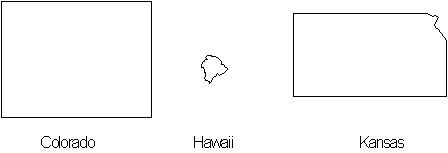
Figure 4.45 Colorado,
Hawaii and Kansas seen in ![]() -dimension plane.
-dimension plane.
We begin by looking at the different fractal
structures of states in the United States of America. Our first
comparison is between Colorado and
Hawaii. In ![]() -dimensions you can see that Colorado and Hawaii have
perimeters that are quite different. Colorado's boarders are formed by
four straight lines while Hawaii has a rugged coastline. Here we see that a
smaller state can be the one with a longer coastline. In
-dimensions you can see that Colorado and Hawaii have
perimeters that are quite different. Colorado's boarders are formed by
four straight lines while Hawaii has a rugged coastline. Here we see that a
smaller state can be the one with a longer coastline. In ![]() - dimensions the two states
formations are quite similar with their mountainous terrain, whereas another
state like Kansas, which is basically flat would a have considerably lower
dimension.
- dimensions the two states
formations are quite similar with their mountainous terrain, whereas another
state like Kansas, which is basically flat would a have considerably lower
dimension.

Figure 4.46 Colorado,
Hawaii and Kansas seen in ![]() -dimensional space.
-dimensional space.
Now what happens if we look at California, in ![]() -dimensions it has boarder properties of both Colorado and
Hawaii, with coastal properties on its west side and straight boarders on its
east side. In
-dimensions it has boarder properties of both Colorado and
Hawaii, with coastal properties on its west side and straight boarders on its
east side. In ![]() -dimensions it shares traits with all three states, by having
the mountainous terrain of Colorado and Hawaii in regions such as the Sierra
Nevada Mountains and the flat plains found in Kansas in its Central Valley.
Having more than one distinctive fractal characteristic puts it in the
classification of a multi-fractal. In a multi-fractal calculation, an object's varying dimensions are measured
and a record is kept of how much of each dimension is found. Multi-fractals are
discussed further in Chapter 6.
-dimensions it shares traits with all three states, by having
the mountainous terrain of Colorado and Hawaii in regions such as the Sierra
Nevada Mountains and the flat plains found in Kansas in its Central Valley.
Having more than one distinctive fractal characteristic puts it in the
classification of a multi-fractal. In a multi-fractal calculation, an object's varying dimensions are measured
and a record is kept of how much of each dimension is found. Multi-fractals are
discussed further in Chapter 6.
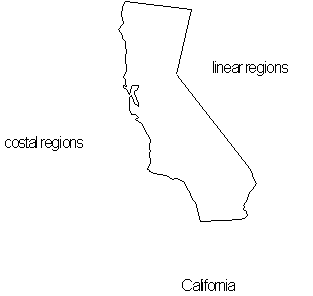
Figure 4.47 California
the multi-fractal
In the following game we are going to look at and
then measure objects for their different fractal dimension.
 Measurements, calculating the
dimensions of different objects.
Measurements, calculating the
dimensions of different objects.
How
long is anything anyway? How long is the coast of Britain, the shore of Santa
Cruz or the length of the Amazon River? As we have seen earlier the answer
depends on what scale you measure them. We typically would not use the same
device to measure a rock as a mountain. For this fractal experiment you will
measure things around you. The measurement sticks you will need are a tape
measure, a foot ruler and a yard stick. If these things are not available or
you want to be unconventional you can use other things too like a baseball
card, sticks of varying lengths, a shoelace, or almost anything you can find to
measure around an object. You can make up you own units for them, for example:
stiff baseball card units, chop stick units or even 'Fractal Exploration' book
units. For units of measurement are just items with lengths assigned to them.
One note: for doing your calculations, if you use your own units you will have
to calculate a length relationship between the different 'object rulers' you
use, such as three stiff baseball cards are the length of a shoe.
Step 1: Find objects with different
dimensions to measure. For a low dimensional object a flat table is a good
choice. It will serve as a reference source for a standard Euclidean object.
For objects of higher dimension you can use contoured chairs, house plants, a
kid brother or sister, or any other objects with parts sticking out requiring
measurements to be made around those parts. One thing to be careful of is,
since you are measuring a perimeter length you must follow the same path for each measurement.
Step 2: Take each object and measure
the same perimeter for each of your different ruler lengths, recording the
results on your chart as seen in Figure 4.48. This will show you how different
rulers measure different lengths.
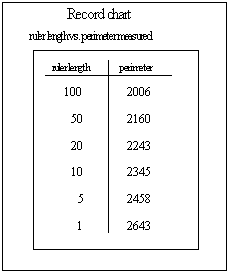
Figure 4.48 Chart to
record the measured lengths of objects from different sized 'rulers'.
Warring: this section is part of a
more advanced exercise and therefore may be skipped. The results vary widely do
in part to your ruler's limited accuracy and scaling range. The main propose
here is to give you an idea on how to physically calculate fractal dimension
using the Richardson method.
Step 3: Take the recorded data you have
recorded of perimeter vs. measured length, convert the data to its logarithmic
values and plot it on a piece of graph paper.
You will find graph paper in Appendix C. Now calculate the slope, this should
roughly correlate to the slope dimension ![]() . Now place
. Now place ![]() into the equation
into the equation ![]() to calculate the
objects full perimeter dimension.
to calculate the
objects full perimeter dimension.
We have look at the Richardson Method to calculate
the fractal dimension of an objects perimeter. In the next section we will use
the Box Counting Method of counting area and volume to calculate an object's
fractal dimension.
The Box Counting Method
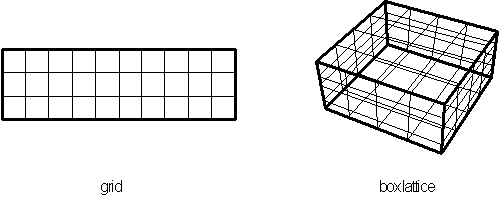
Figure 4.49 Box
counting method using divided segments, grid for a plane space and cube lattice
for a volumetric space.
The Box
counting ratio method ,also known as the Brute force method or Grid
Method is an estimation procedure for calculating the fractal dimension of
complicated objects. It is most effectively used when you cannot calculate an
objects dimension with numerical formulas or accurately determine a slope
dimension of an irregular shapes. For example, it would be difficult to calculate scribbles, dust,
ocean waves, or clouds using other methods. This accounts for its popularity in
spite of its counting resolution's limited accuracy.
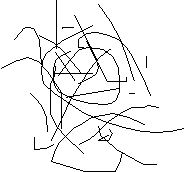
Figure 4.50 Some of
the many objects best calculated using the box method.
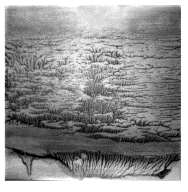
This method is popular because it is straightforward
and adaptable to many situations. If you can contain an object within squares
or boxes, then you can perform a statistical analysis to determine its physical
dimension. You can use this method to
calculate dimensions for a very small object like Cantor's dust or for a very
large object like a mountain range. You could even calculate the fractal
dimension of the universe--at least what we know of it.
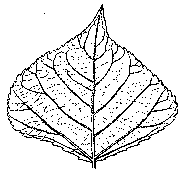

Dimensions
Found in a Plane Space
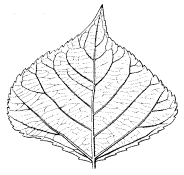
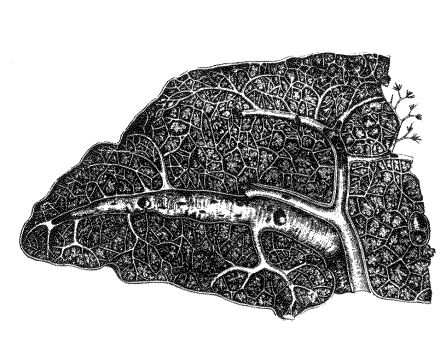
To calculate the fractal dimension of images in a
plane, you begin by covering an
area with grids of different mesh sizes. Then, you
compare the grid sizes and the
number of squares containing at least a part of the
image. The ratio of grid sizes to number of grids containing the object
establishes the dimension.
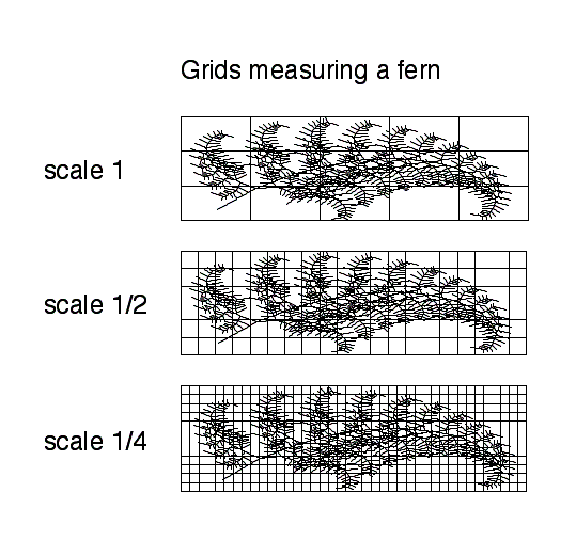
Figure 4.51 Measuring
a fern's dimension with different grid sizes.
Note: Even though this process generally produces
accurate results, there are limitations with this method. For example, if tiles
are used to cover a measured area, the calculated dimension can not exceed
2, because a fractal's dimension can
not exceed the dimension of the units used to measure it.
Dimensions
Found in a Volumetric Space
To calculate dimensions with volumetric space, you
use a similar method as in calculating the dimension of a plane, only instead
of using tiles you use boxes. These
boxes are mapped out to form lattices of varying sizes ( a ![]() - dimensional grid ) called an array see Figure 4.52. Then by
counting the boxes containing at least part
of the object a ratio is established between the box size and its
corresponding count. This ratio at different scales determines the object's
dimension.
- dimensional grid ) called an array see Figure 4.52. Then by
counting the boxes containing at least part
of the object a ratio is established between the box size and its
corresponding count. This ratio at different scales determines the object's
dimension.
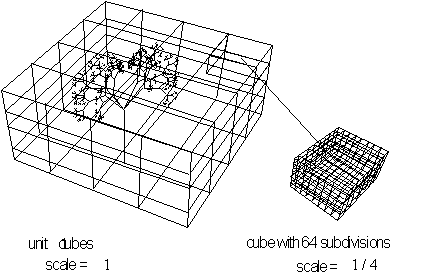
Figure 4.52 Box
counting method for volume a ![]() -dimensional lattice.
-dimensional lattice.
Actual Calculations
Now lets examine how the grid method is used to
measure the fractal dimension of an image found in a plane.
•
First, for each grid mesh size, count the number of grids that contain the
image.
•
Now pair all combination of counted
values and place them in the standard equation for the Box Counting Method. The
dimension is calculated by the equation ![]() , where
, where ![]() is the number of
squares containing the image and
is the number of
squares containing the image and ![]() is its grid scale. Now average your results to get a good
estimate of the objects fractal dimension. It should be noted that generally
finer grids produce a more accurate measured dimension. This is due in part to
amount of variations that can arise in counting regions dependent on how a grid
is placed see Figure 4.53. Placing
grids in the same position with increased subdivisions adds in to decrease
fluctuations see fern in Figure 4.51.
is its grid scale. Now average your results to get a good
estimate of the objects fractal dimension. It should be noted that generally
finer grids produce a more accurate measured dimension. This is due in part to
amount of variations that can arise in counting regions dependent on how a grid
is placed see Figure 4.53. Placing
grids in the same position with increased subdivisions adds in to decrease
fluctuations see fern in Figure 4.51.
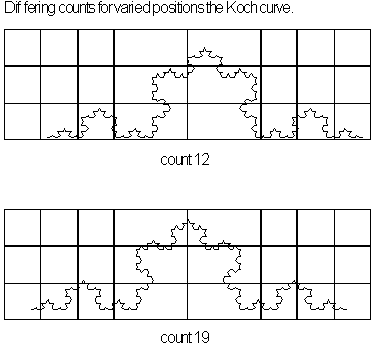
Figure 4.53 Variation
in grid placement.
Alternative method:
• Plot the values of ![]() vs.
vs. ![]() on a
on a ![]() graph. Then take the averaged slope as the calculated fractal
dimension, see Figure 4.54.
graph. Then take the averaged slope as the calculated fractal
dimension, see Figure 4.54.
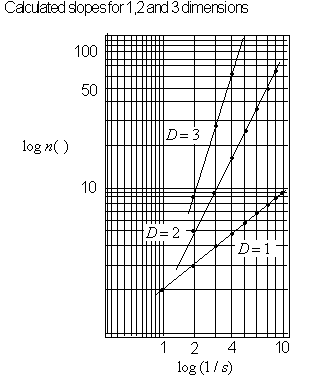
Figure 4.54 Measuring
an objects dimension by comparing values, ![]() vs.
vs. ![]() , plotted on a
, plotted on a ![]() graph.
graph.
You can use the same method for volumetric
measurements of dimension by using cube boxes, as seen in Figure 4.52.
Now lets do the calculations for the Koch curve, and
compare the results to previous methods.
Measuring the
Fractal dimension of the Koch curve Using the Box counting Method.
We begin by counting the number of squares that
contain part of the Koch curve for each grid. Here we use three grids with
ratios 1 : 1/2 : 1/4 with counts 18, 41 and 105 as seen in Figure 4.55, Figure
4.56 and Figure 4.57 respectively.

Figure 4.55 The Koch
curve with unit 1 grid size, with 18 containing the curve.

Figure 4.56 The Koch
curve with unit 1/2 grid size, with 41 containing the curve.

Figure 4.57 The Koch
curve with unit 1/4 grid size, with 105 containing the curve.
I. ![]() .
.
II. ![]() .
.
III. ![]() .
.
Figure 4.58 Calculating dimensions from three
different grids using the Box Counting Method.
Now taking the data from our three grids and placing
them into the Box Counting Equation, we are left with three approximate
calculated dimensions with sizable fluctuations in value see Figure 4.57. Their
average of ![]() is a reasonably close
result to the actual value of
is a reasonably close
result to the actual value of ![]() , if you were to do more calculations with different grid
sizes you should expect most values to fall within a certain range. If you were
to refine your measurements further with considerably smaller grids an increase
in accuracy should be reflected in the answer.
, if you were to do more calculations with different grid
sizes you should expect most values to fall within a certain range. If you were
to refine your measurements further with considerably smaller grids an increase
in accuracy should be reflected in the answer.
In Figure 4.59 we show the dimension of the Koch
curve by counting grid boxes containing the object and graphing the results on
a ![]() plot.
plot.
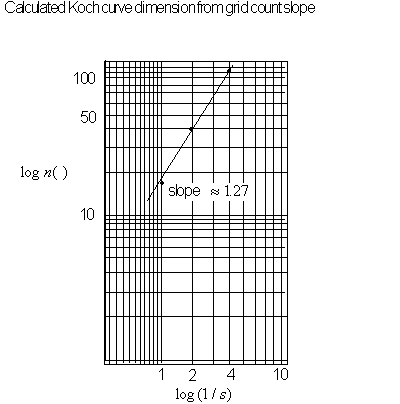
Figure 4.59 Using the
Koch curve data to formulate a slope dimension.
Now we are going to look at different areas of
fractal dimension using a garden vegetable, the Broccoli Romanesco. The
Broccoli Romanesco is an ideal candidate because its fractal structure can be
seen in different ways at several levels of magnification.
The Broccoli
Romanesco, a fractal seen in three different dimensions.
The Broccoli Romanesco exhibits fractal structure in
its perimeter, planar and volumetric dimensions. Lets look at them now.
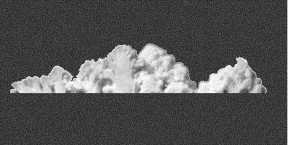
Figure 4.60 Measuring
the Broccoli Romanesco jagged perimeter.
If we look at the perimeter of the Broccoli
Romanesco we can see an outline that bares a 'rough' resemblance to the Koch
curve, see Figure 4.61. Notice the continuos jaggedness seen at different
levels of magnification even at a close distance. The measurement of the
jaggedness of this irregular boundary is its perimeter dimension. We can
measure its dimension by comparing the number of squares containing its
perimeter at different grid sizes.
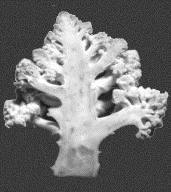
Figure 4.61 A cross
sectional view of the Broccoli Romanesco.
In figure
4.61 we see a Broccoli Romanesco as it looks when it is cut in half. This
revealing cross sectional slice gives a view of it planar dimension. By measuring the number of squares that are
filled at different grid sizes a comparison can be made that corresponds to its
planar dimension. Notice its self-similar branching structure that can be seen
to at least 4 levels.
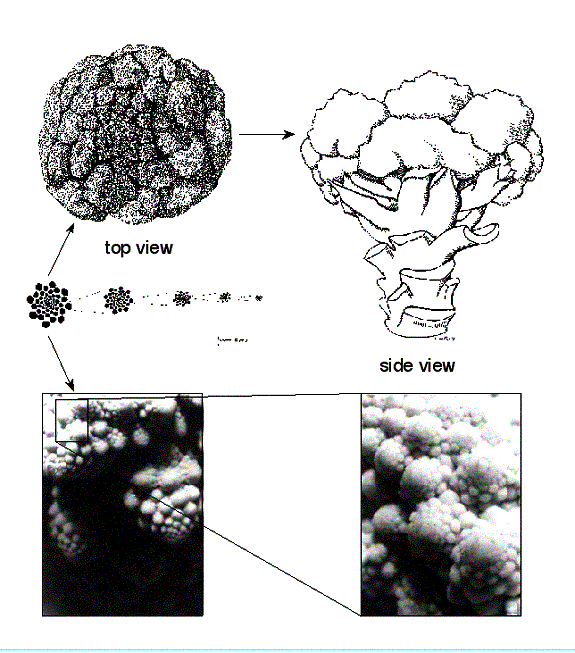
Figure 4.62 Close-up
views of the Broccoli Romanesco at different levels of magnification.
In Figure 4.62 we see a two close-up views of the
Broccoli Romanesco, notice the difficulty in gauging its true size without a
scale reference. In Color Plate 24 we see a Broccoli Romanesco as it looks in
its entirety. This form gives a view of its volumetric dimension. If you look
closely at its top regions you can see the same type of spiral cones that you
see from a distance only smaller. This self similar structure can be seen to at
least 3 levels of magnifications. By creating lattices at different sizes and
counting the number of regions that contain at least part of the object,
calculations can be made that corresponds to its volumetric dimension. This
procedure can be greatly simplified if the structure's form can be entered and
stored as an array of numbers in a
computer. With this alternate way, a computer can create a mathematical lattice
that could partition the object's spatial values without having to physically
divide it.
It is the Box Counting method we use to calculate
the fractal dimension of most things
found in nature, see Color Plate 25 to visually compare the dimensions of
different clouds. Now lets use grids to measure planar dimension.
 Grid Game for Measuring
Dimensions.
Grid Game for Measuring
Dimensions.
In the grid game, you can use the different size
grids found in Appendix C to calculate dimensions of different exact fractals
like we did with the Koch and see how well their dimensions correlate to their
known dimensions. It might come in handy to copy these grids onto
transparencies to use in your calculations if you do not want to mark your
fractals with grid lines. Also included
in Appendix C are various grid maps for Great Britain and the Monkey tree that
can be used to calculate their dimension.
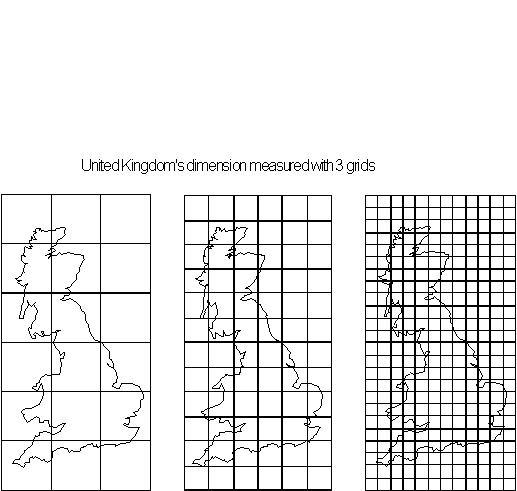
Figure 4.63 Three
different size grids for Great Britain: scale ![]() , scale
, scale ![]() and scale
and scale ![]() .
.
Step 1: Find a fractal to measure
whose dimension you know and can be measured by the grid sheet you are using.
This fractal can be one you find in a book ( for example this one ) or one that
you create and printout in FractaSketch. In FractaSketch the dimension value
can be read from the menu bar of the program.
Step 2: Take your fractal and
divide it with evenly distributed grid squares with known grid values. A good
technique is to place different grid size transparencies over the object and count the contained squares as seen with
Britain in Figure 4.63. For a basic exercise you might want to start by carry
out calculation using these grids .
Step 3: Count the contained squares
for the different grid sizes, as we did with the Koch curve earlier in this
chapter, and record their values.
Step 4: Place the recorded values
into the formula ![]() and calculate the
image's fractal dimension.
and calculate the
image's fractal dimension.
After you feel reasonably comfortable with the
accuracy of your calculated dimensions, you can use this technique to examine
other fractals whose dimensions you do not known exactly--such as a fern,
counties on a map or even a newspaper. Remember due to the limited accuracy of
our measurements, dimensional values within 10% of the correct value are
consider quite reasonable.
 Grid Game for Measuring Dimensions on the Computer.
Grid Game for Measuring Dimensions on the Computer.
In the same way you can calculate dimension by using
grids on paper, you can also calculate the dimension of images using a
Macintosh paint or graphics program.
Step 1: Paste an images from FractaSketch, MandelMovie or even an image
of a scanned photograph onto the pallet on your paint program. Save the image
now, so you can recall it for every new grid placed if you need to, you might
want to make a backup copy of your picture in case accidentally alter it or
save it with a grid on it.
Step 2: If your paint or graphics program does not include an option for
creating grids with varying mesh sizes, make the grids first in the program and
paste them in from the "�" menu in your
"Scrapbook". Make 5 grids in
sizes of 25, 20, 15, 10 and 5 pixels square. You can make alternate size grids
if you want. It is important when pasting the grids over the object that the
white regions not be included. This is done by setting the white regions to be
transparent in your paint or graphics program.
This will allow you to see the object after the grids have been placed.
Instructions on how to do this should be found in your paint or graphics
program.
Step 3: Place a grid divided into squares of equal size (say 25 pixel
square) and count the number of squares that contain part of the curve. Repeat
the experiment by counting how many squares contain the object when the grids
are 20 pixels square, then 15 square , then 10 square, then 5 square. If your
program does not generate grids you will have use five duplicate picture files
or reopen the picture file each time without saving the changes of the added
grid.
Step 4: Count and record the number
of squares containing the object for the different grid sizes.
Step 5: Place the recorded values
into the formula ![]() and calculate the
image's fractal dimension.
and calculate the
image's fractal dimension.
Step 6: If you know the fractals dimension in FractaSketch, compare the
results and see how close they correlate.
The fractal dimensions calculated here are averages
of the whole structure and can not discern between the dimensions of its
different regions. This type of work deals with multi-fractals. [15] which we will see with
greater detail in Chapter 6.
We have looked at 3 major ways of calculating
fractal dimension.
• Calculations of exactly
self-similar dimension, using mathematical formulas.
• Richardson's dimensional
measurements of divided segments. Here fractal dimensions correspond to the
slope correlating to the length of the "ruler" used and its overall
measurement.
• Box-counting dimension, calculating the containment of an object at different measurements.
In the next chapter we will look at ways to generate
fractals with equations. This procedure is responsible for producing many of
the colorful fractals that almost defy description. In Chapter 6 we will look at fractals with the similar shapes and
dimensions to the ones we have calculated in this chapter. These fractals are
generated by taking points and mapping them to other regions, we call this
technique Iterated Function Systems.